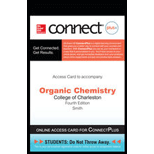
Concept explainers
(a)
Interpretation: The given pair of compounds is to be classified as isomers or resonance structures.
Concept introduction: Isomers are defined as the molecules having the same molecular formula but different arrangement of atoms. The arrangement of atoms in resonance structures remains same but the position of non-bonded electrons and pi bonds is different.
(b)
Interpretation: The given pair of compounds is to be classified as isomers or resonance structures.
Concept introduction: Isomers are defined as the molecules having the same molecular formula but different arrangement of atoms. The arrangement of atoms in resonance structures remains same but the position of non-bonded electrons and pi bonds is different.
(c)
Interpretation: The given pair of compounds is to be classified as isomers or resonance structures.
Concept introduction: Isomers are defined as the molecules having the same molecular formula but different arrangement of atoms. The arrangement of atoms in resonance structures remains same but the position of non-bonded electrons and pi bonds is different.
(d)
Interpretation: The given pair of compounds is to be classified as isomers or resonance structures.
Concept introduction: Isomers are defined as the molecules having the same molecular formula but different arrangement of atoms. The arrangement of atoms in resonance structures remains same but the position of non-bonded electrons and pi bonds is different.
Want to see the full answer?
Check out a sample textbook solution
Chapter 1 Solutions
Organic Chemistry - Access (Custom)
- Draw out the organic shorthand for the molecules below, and then draw another possible resonance structure of the same molecule next to with arrows to show electron movement. -CH3CH2CONH3 -CH3CH2COOHarrow_forwardThe carbon–carbon bond length in C2H2 is 1.20 Å, that inC2H4 is 1.34 Å, and that in C2H6 is 1.53 Å. Near which ofthese values would you predict the bond length of C2 tolie? Is the experimentally observed value, 1.31 Å, consistent with your prediction?arrow_forwardWhich ones have an oxygen with a formal charge of -1?arrow_forward
- Draw a second resonance structure and the hybrid for each species, and then rank the two resonance structures and the hybrid in order of increasing stability.arrow_forwardWhich heteroatom don't contain heterocyclic compounds? a. Phosphorus b. Oxygen c. Nitrogen d. Sulfurarrow_forwardConsider the compound C₂H₃N. Which one of the structures in Figure 4 is the best representation of this compound based on your current knowledge? * A B C D All these structures are good representations of the compound.arrow_forward
- Draw projection (lewis) drawings of all isomers of C5H12. What type of isomerism do they represnet?arrow_forwardBased from the figures below, which of the following statements is correct?I. A is an skeletal isomer of D while B and C are positional isomers.II. B and C are alkynes with six Carbons but their structures are different.III. All of the above have the possibility of a cis-trans isomerism.arrow_forwardThe curved arrow notation introduced in Section 1.6B is a powerful method used by organic chemists to show the movement of electrons not only in resonance structures, but also in chemical reactions.Because each curved arrow shows the movement of two electrons, following the curved arrows illustrates what bonds are broken and formed in a reaction. Consider the following three-step process. (a) Add curved arrows in Step [1] to show the movement of electrons. (b) Use the curved arrows drawn in Step [2] to identify the structure of X. X is converted in Step [3] to phenol and HCl.arrow_forward
- Draw an acceptable Lewis structure from each condensed structure, such that all atoms have zero formal charge. a. diethyl ether, (CH3CH2)2O, the first general anesthetic used in medical procedures b.acrylonitrile, CH2CHCN, starting material used to manufacture synthetic Orlon fibers c.dihydroxyacetone, (HOCH2)2CO, an ingredient in sunless tanning products d.acetic anhydride, (CH3CO)2O, a reagent used to synthesize aspirinarrow_forwardDraw an acceptable Lewis structure from each condensed structure, such that all atoms have zero formal charge. a diethyl ether, (CH3CH2)2O, the first general anesthetic used in medical procedures b. acrylonitrile, CH2CHCN, starting material used to manufacture synthetic Orlon fibers c.dihydroxyacetone, (HOCH2)2CO, an ingredient in sunless tanning products d.acetic anhydride, (CH3CO)2O, a reagent used to synthesize aspirinarrow_forward1. What is resonance contributor in which one or more atoms bears a formal change and the most stable resonance form? 2.what is the process of distributing electron pairs in a molecule? 3. Are organic molecules which are less sterically hindered more attractive than those which are more sterically hindered?arrow_forward
 Chemistry: The Molecular ScienceChemistryISBN:9781285199047Author:John W. Moore, Conrad L. StanitskiPublisher:Cengage Learning
Chemistry: The Molecular ScienceChemistryISBN:9781285199047Author:John W. Moore, Conrad L. StanitskiPublisher:Cengage Learning
